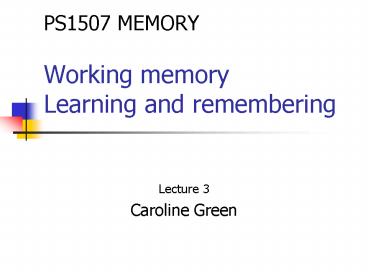PS1507 MEMORY Working memory Learning and remembering PowerPoint PPT Presentation
1 / 20
Title: PS1507 MEMORY Working memory Learning and remembering
1
PS1507 MEMORYWorking memoryLearning and
remembering
- Lecture 3
- Caroline Green
2
Visuo-Spatial Working Memory
- Temporarily holds and allows manipulation of
visual images - Visual cache inner scribe (Logie, 1986,1995)
3
Where are the WM stores?
- PET scans (Smith, Jonides Köeppe(1996))
- Phonological loop predominantly left hemisphere
(fMRI imaging storage- a left inferior
parietal area, rehearsal- left prefrontal areas.) - Visuo-spatial sketchpad predominantly right
hemisphere
4
Central Executive
- Limited capacity supervisory attentional system
involved in rehearsal, reasoning,
planning,decision making - Possibly located in frontal lobes, but also
prefrontal activity involved.
5
Working (short-term) memory
Maintenance rehearsal
Phonological rehearsal loop
Executive control system
Visuospatial sketchpad
Episodic buffer
6
Working Memory in Everyday Life
- Short-Term Memory
- Acquiring Language
- Mental Arithmetic
- Reading Comprehension
- Mental Workload
- Keeping track moment to moment
- Reasoning and decision making
- Mental imagery
- Creative Thinking
7
Learning and Remembering
- Seven sins of memory(Schacter(1999))
- Transience
- Absent-mindedness
- Blocking
- Misattribution
- Suggestibility
- Bias
- Persistence
8
Three sins of omission
- Transience weakening or loss of memory over
time - Absent-mindedness lack of attention to what we
need to remember - Blocking unable to find info. we are trying to
retrieve
9
Four sins of commission
- Misattribution assignment of a memory to the
wrong source - Suggestibility memories implanted via leading
questions, comments and suggestions - Bias the influence of our current
knowledge/beliefs on how we remember our past - Persistence repeated recall of info. we would
prefer to forget
10
Learning and Remembering
- Memory declines over time (Ebbinghaus,1885)
- Learned list of nonsense syllables. Varied delay
between initial learning and relearning them to
same standard of retention. - Method of Savings
11
Method of Savings
- Learned list tested until list perfect took
20 trials - Later testing took 10 trials of relearning
until list perfect - Called method of savings because saved 10 trials
on second learning, so shows some of list
remembered. The fewer the trials on second
learning, the better the remembering of the first
list.
12
(No Transcript)
13
Forgetting
- Greater delay more relearning required.
Forgetting very rapid at first, slows down as
delay increases. Most dramatic drop in first nine
hours, especially in first hour. - Application to real-life memories e.g. knowledge
learned at school/university,. Names, faces ,
personal events. - Applies as a general principle of forgetting.
14
Amount of learning versus amount learned
Ebbinghaus
20
15
10
Time to Re-learn on Day 2
5
0
8
16
24
32
42
53
64
Repetitions of Learning on Day 1
15
Total time hypothesis
- Virtually straight line relationship
- between repetitions of learning and time to
relearn. - Obeys simple rule that amount learned depends on
time spent learning.
16
Distributed learning is better!
- Dividing learning evenly across 2 days much more
effective than putting all learning into 2nd day.
Distribution of practice effect. - Learning little and often is best. Especially
important in studying academic material (Zimmer
and Hocevar, 1994) - Longer breaks between practice sessions
facilitate memory in complex tasks more than
simple tasks. (Donovan Radosevich,1999)
17
Repetition and Memory
- Repetition of stimuli different from Rehearsal.
- e.g. Stamps and Coins
18
References
- Schachter, D.L. (1999) The seven sins of memory.
American Psychologist, 543, 182-203 - Schachter, D.L. (2003) How the Mind Forgets and
Remembers. The seven sins of memory. London,
Souvenir Press Ltd.
19
Web sites
- http//www.brainconnection.com/topics/?mainfa/wor
king-memory - http//www.nature.com/cgi-taf/DynaPage.taf?file/n
rn/journal/v4/n10/abs/nrn1201_fs.html (recent
overview by Baddeley) - http//cogweb.ucla.edu/Abstracts/Baddeley_00.html
(episodic buffer) - http//www.psypress.co.uk/ek5/resources/demo_ch06-
sc-02.asp - (working memory)
20
Web sites
- http//www.brain.web-us.com/memory/hermann_ebbingh
aus.htm - http//www.mtsu.edu/studskl/memprinc/disprac.html
- http//www.brain.web-us.com/memory/improving_memor
y.htm - http//www.abdn.ac.uk/diss/library/ejournal/a4.htm

